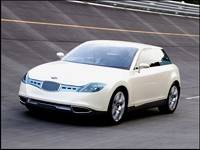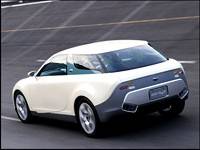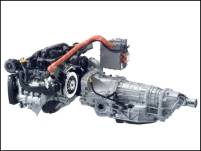New Hybrid Drivetrain Could See Production In 2007Subaru is currently one of the few Japanese automobile manufacturers that hasn't brought a hybrid powertrain to the table, and that's a problem they plan to
 |
| The B5-TPH follows the current styling trend towards crossovers, or shooting brakes; two-door, sporty wagon. (Photo: Subaru Canada) |
correct with their B5-TPH concept, no doubt with help from Toyota, the undisputed hybrid leader, which recently purchased 8.7 percent of the shares General Motors previously held in Japanese automaker Fuji Heavy Industries and then divested, back in October of last year (see automotive news section of this site for Nov 18, 2005: New Relationship between Toyota and Subaru Beginning to Take Shape).
Standing for a Star Trek-like "Turbo Parallel Hybrid," the TPH combines hybrid efficiency with sport-coupe performance. Unlike Toyota's Hybrid Synergy Drive, the sporty three-door THP uses a beautifully simple motor assist system combined with the Subaru's already excellent turbocharged boxer engine. Mounting a single 10-kilowatt motor between the vehicle's engine and automatic transmission, the combination not only provides power in the mid-speed ranges right where the turbocharger is active, as with conventional turbo models; but it also delivers excellent acceleration and fuel economy courtesy of the electric motor's ability to deliver 100 percent of available torque throughout the rev range.
O
 |
| The body design is reportedly not due to make it into production; more's the pity. (Photo: Subaru Canada) |
f course, applying electric motor assist to an engine is the simplest part of any hybrid setup. The real trick is in the electrical supply system; and for that Subaru turned to its Fuji Heavy Industries parent to develop a new high-performance battery. FHI has been concentrating specifically on the development of power storage systems and the application of high-technology firm NEC's Lamilion Energy high-capacity manganese Li-ion batteries on prototype vehicles, including the B5-THP. In addition, FHI is currently conducting performance tests on prototype cells of the new Li-ion capacitor (no wonder Toyota invested so heavily). The eventual successful commercialization of Li-ion capacitors for compact cars would open up many other business opportunities, including helping to meet the increased demand for new hybrid buses, trucks, and other passenger vehicles. This new capacitor also has the potential to be an alternative to conventional lead-acid batteries in the future.
And finally, for even grea
 |
| The advanced electrical system can actually charge the battery to over 80% of capacity in mere minutes. (Photo: Subaru Canada) |
ter efficiency, the TPH's gasoline engine adopts the Miller Cycle. A Miller-cycle engine leaves the intake valve open during part of the compression stroke, effectively shortening the compression stroke and lowering the dynamic compression ratio to avoid detonation. However, due to the turbocharger positively pressurizing the intake charge, especially at higher revs, the cylinder still ends up packed with a larger intake charge than would a conventional-cycle engine. In the Subaru B5-TPH, the Miller Cycle turbo boxer engine reportedly operates up to 30 percent more efficiently than a conventional gasoline engine. The last time this technology made it into production was the '90s Mazda Millenia sedan. The car suffered from sluggish acceleration and horrible performance at low revs, a problem Subaru has solved with the electric assist motor. In fact, with 256 horsepower and 253 lb-ft of torque, Subaru claims even better standing-starts than their flagship turbocharged WRX.





